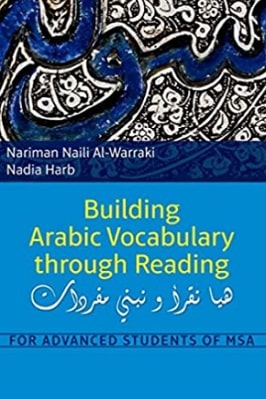
| Building Arabic Vocabulary Through Reading |
| Nariman Naili |
| 310 |
| |
| PDF Direct Download Link |
| Click for Hard Copy from Amazon |
Building Arabic Vocabulary through Reading for Advanced Students of MSA by Nariman Naili AI-Warraki Nadia Harb
BUILDING ARABIC VOCABULARY THROUGH READING
Book’s Introduction
It is well-known that the vocabulary of the Arabic Language-as with many other languages-represents a great challenge for both the non-native student and the instructor.
It is self-evident that extensive reading of texts dealing with an array of topics helps the student to notice frequently occurring words and idiomatic expressions.
By observing them as they appear in multiple contexts, the student will then be able to retain them on the level of recognition and, ultimately, on the level of production.
The first objective of this book is to introduce the student to texts covering a number of different themes (historical, political, cultural, and economic).
These texts have been carefully selected to shed light on certain controversial issues, which are likely to arouse students’ attention and interest.
They also aim to serve as a starting point for students to build their vocabulary, practice reading strategies (skimming, scanning, and careful reading), and develop guessing, strategies for vocabulary recognition.
The second objective is to direct the attention of the student to Modern Standard Arabic (MSA) connectors, which are equally crucial for comprehension and production as they provide the skeleton for fluent and connected expressions.
These skills needed for connected discourse, whether verbally or in writing, many non-native students lack.
The third objective is to expose students to a number of culturally or politically important issues related to Arab society, in general, and to Egyptian society, in particular.
All the material used is authentic, but in some cases sections have been summarized or connectors added for teaching purposes, as indicated when acknowledging the source.
The fourth objective is to review the grammatical structures of MSA styles occurring in the texts, which the students will have previously studied in their primary and preparatory classes. These need review for students to comprehend the meaning of the text and to be able to use them in their writing.
The texts have been ordered on the basis of linguistic complexity and, to a certain extent, according to the topic they tackle. An experimental copy of the book has been utilized for the last four years at the Department of Arabic Language Instruction (ALI) at the American University in Cairo, leading to the consensus that the first fifteen lessons are appropriate for high intermediate level students and the rest for advanced students.
There are different exercises after every five lessons, the first part of which focuses on vocabulary building and connectors and the second part on the grammatical structures which occur in the texts.
These drills are gathered in an appendix at the end. A glossary of all vocabulary is also included, to facilitate the process of vocabulary building and retention for the student.
Lastly, for colleagues who plan to teach from this book, it is organized in such a way as to give the flexibility to decide from which chapter to start depending on their students’ proficiency level.
To read more about the Building Arabic Vocabulary Through Reading book Click the download button below to get it for free